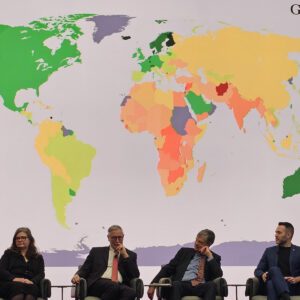
Mar 25, 2024 International Day of Happiness
On June 28, 2012, the United Nations General Assembly declared March 20 the International Day of Happiness following a resolution introduced by Bhutan, who famously declared that it would track national progress via a Gross National Happiness metric rather than GDP. The annual World Happiness Report (WHR) was typically released on or around March 20 in the succeeding years. However, the first WHR appeared on April 1, 2012 (perhaps prompting media comments about April Fool’s Day). The key partners underpinning the annual World Happiness Report are the Gallup organization, Oxford University’s Wellbeing Research Centre, and the UN Sustainable Development Solutions Network at Columbia University.
The annual report is written by independent experts whose views do not necessarily reflect those of any specific organization or agency. The content of each report is the responsibility of the report’s editors. The first World Happiness Report introduced important concepts and ideas regarding the understanding of global happiness and well-being and set the stage for the subsequent annual editions that have continued to deepen global acceptance and understanding of happiness and identify public policy approaches influencing individual and national well-being.
 On March 20, 2024, in Washington, DC, the 2024 World Happiness Report was released at an event at Gallup’s offices. The release event featured various speakers, including Professor John Helliwell, one of the founding editors of the first World Happiness Report in 2012, and the ambassadors from Finland, Iceland, and Switzerland, countries that have consistently been ranked among the happiest in the world. The ambassador from Finland, the country that has been ranked the happiest in the world for the past seven years, commented that there was a certain level of disbelief among Finns that they were the happiest country in the world. He noted that, despite Finland sharing a long border with Russia and being a neighbor to a horrible war in Ukraine, Finns have retained their level of happiness. That observation led to a panelist quoting Danish philosopher Søren Kierkegaard, who ironically commented that “people settle for a level of despair they can tolerate and call it happiness.” Several panelists also noted that easy access to nature might be a possible reason for the high happiness ranking of the Nordic countries.
On March 20, 2024, in Washington, DC, the 2024 World Happiness Report was released at an event at Gallup’s offices. The release event featured various speakers, including Professor John Helliwell, one of the founding editors of the first World Happiness Report in 2012, and the ambassadors from Finland, Iceland, and Switzerland, countries that have consistently been ranked among the happiest in the world. The ambassador from Finland, the country that has been ranked the happiest in the world for the past seven years, commented that there was a certain level of disbelief among Finns that they were the happiest country in the world. He noted that, despite Finland sharing a long border with Russia and being a neighbor to a horrible war in Ukraine, Finns have retained their level of happiness. That observation led to a panelist quoting Danish philosopher Søren Kierkegaard, who ironically commented that “people settle for a level of despair they can tolerate and call it happiness.” Several panelists also noted that easy access to nature might be a possible reason for the high happiness ranking of the Nordic countries.
The 2024 World Happiness Report focused on the happiness of different age cohorts in specific countries and worldwide. For example, in 2024, the USA dropped out of the top twenty countries in the happiness rankings. This drop in ranking was due to lower happiness levels among Americans under 30 years old. Whereas American boomers scored a relatively high 7.1 (out of 10) on the life satisfaction scale (placing them at number 10 in the country rankings of similar age cohorts), young Americans scored 6.2 on the scale, scoring them 62 in the country rankings. The happiest youth cohort in the world was in Lithuania, not in Finland or one of the other Nordic countries.
The changing levels of happiness or life satisfaction across the human lifespan have produced a vigorous and ongoing debate. Blanchflower and colleagues argued a U-shaped relationship exists between happiness and age, with happiness levels highest among a country’s youth and elderly and lowest among people 40 to 50 years old. Research on age and happiness in the US has identified concerns regarding well-being among the country’s youth, which the latest World Happiness Report has confirmed. However, the cause of the decline in youth well-being has not yet been identified, although social media use is a possible “smoking gun.”
The pandemic was mentioned as a possible reason for the lower happiness levels among young people in North America (both the USA and Canada). However, the pandemic per se may not be the immediate cause of low happiness levels. During the early phases of the pandemic, face-to-face interactions were significantly reduced or eliminated and replaced by online communication. Online communication tends to be associated with a negative valence (no facial expressions or body language to add context to the words). There was little focus on the issue of social media’s impact on social and mental health among the day’s panelists until the final speaker, Senator Chris Murphy from Connecticut. Senator Murphy is one of four sponsors (two Democrats and two Republicans) of a bipartisan bill, The Protecting Kids on Social Media Act, that aims to protect American youth from the negative consequences of social media.
Senator Murphy noted that the bill would establish 13 as the minimum age for children to access and use social media, would require parental consent for access to social media for all 13- to 17-year-olds, and would also prevent social media companies from using algorithms to feed content to social media users under 18. He noted that in discussions with children, he found little concern over the first two provisions of the bill but significant worry over the algorithm element. Nevertheless, he argued that the evidence is clear that social media is affecting the mental health of American children and appears to be making them more depressed. Something has to be done, and that is why Senators from the liberal wing of the Democrats and the conservative wing of the Republicans have agreed to cosponsor the legislation. For readers interested in the level of screen time use by consumers in the US today, please see the Verizon Consumer Connections Report 2023. The numbers are eye-popping!
Credit: Helliwell, J.F., Layard, R., Sachs, J.D., De Neve, J.E., Aknin, L.B., & Wang, S. (Eds). (2024). World Happiness Report 2024. University of Oxford: Wellbeing Research Centre.


